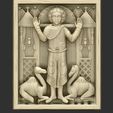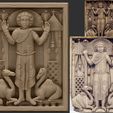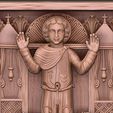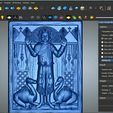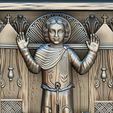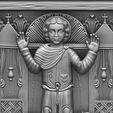As the Monastery of St Mena in Maryut celebrates 17 centuries since the martyrdom of its patron saint, and 50 years since the foundation stone of the modern monastery was laid, Watani reviews a gem of a book on St Mena and the monastery
Despite the countless books and booklets that have been published about St Mena, The Great Saint Mena, the Miraculous is unique in that it offers the reader numerous references, codices and manuscripts to verify every detail cited in the book.
The 520-page book prepared and published by St Mena Coptic Orthodox Monastery in Mayrut is among the first to present a complete English version of the life of Saint Mena and the history of his desert monastery in Maryut, some 70km southwest Alexandria.
The book cites the details of St Mena’s birth, life, martyrdom and burial in the 4th century, as well as the history of the great 5th-century basilica in whose crypt he was buried and the thriving town which later sprung around the basilica. For some 200 years the place was the destination of pilgrims from many places in the world, and flourished as one of the most important religious sites in the Coptic Church. The book then traces the town’s 8th-century pillage and decline, and the last mention of the church at the end of the 12th century, after which it passed into oblivion. It relates the story of the miraculous discovery of the saint’s relics and their removal to Cairo in the 13th century. Finally, it cites the German excavations which brought it back to light in 1905 and its modern revival at the hands of Pope Kyrillos VI in the 1960s and which today make the monastery one of the most significant of Egypt’s modern ones.
What Mena means
Following a preface by the monastery fathers, the book begins with an introduction which explains the significance of martyrdom and monasticism, as well as martyrs in general and St Mena in particular, in the Coptic Church. It then goes on to trace the history and meaning of the name “Mena” or “Mina”—literally, stable or brave—since it first appeared in ancient heiroglyphs then passed on into Coptic and Arabic. It also cites the titles of St Mina, the most common among which is the “Miracle-Worker” or “Miraculous” and the “One with the Three Crowns”, a reference to St Mina being honoured for celibacy, self-isolation to worship in the desert, and martyrdom.
Before going into the actual details of the book, the introduction gives a briefing on the references used and the methodology applied in the research.
The three crowns
All Coptic and Arabic manuscripts have agreed that St Mena comes from an Egyptian family. His father was the governor of North Africa and his mother was childless. On the feast of the Holy Virgin on the 21st Tobe (29 January), his mother Euphemia beseeched St Mary to give her a child. As she lifted her eyes to the Virgin’s icon, she heard a voice emanating from the mouth of the Babe Jesus in His mother’s arms saying “Amen Mena”.
Mena was orphaned at the age of 14. He inherited great wealth from his parents. He joined the army and became a distinguished officer, beloved by his superiors for his bravery and by those who served under him for his compassion and gentleness.
As the persecution of Christians escalated to unprecedented ferocity in 284 and under the Roman emperor Diocletian and later under Maximianus in 303, Mena retired his office, distributed all his wealth to the needy, and left for the desert where he led a life of worship and asceticism. There, he saw heaven open and heard God’s promise of a share in His Divine kingdom. Mena decided to opt for martyrdom, left the desert and went into town where he publicly admitted he was Christian. He was cruelly tortured, but never succumbed into denying his faith. Finally he was sentenced to death and his body was thrown in fire which, despite burning on for three days, did not hurt his body. Some manuscripts tell that his sister came and bribed the soldiers with money to carry away the body, and took a ship to the city of Alexandria.
Story of the camels
Some historians claim that St Mena was a camel herder because of the two camels commonly depicted in his icon but, the book says, this assumption is easily refuted. The book traces the attempt, during Roman times, to transfer the saint’s relics from one place to another by placing them on a camel to cross the desert. But the camel would not budge, neither did any other camel on whom the relics where placed, and the commander in charge of the move—a pious Christian named Athanasius—decided that it was obvious the saint wished to remain buried at Maryut. He thus kept the relics there and refrained from moving them.
St Mena became the patron of the travellers and the desert caravans. The book cites many miracles on how St Mena guided people who had lost their way in the desert, especially those who were on their way to the monastery, and how he protected them from harm.
A separate chapter in the book deals with the St Mena ampullae, small flat flasks of different diameters made of pottery and manufactured in Maryut. St Mena’s figure in military uniform with hands raised in prayer was carved on the side, with two camels perching each on one side of the saint. It was Kaufmann who first discovered dozens of these flasks, he theorised that they were used by pilgrims to carry oil from the lamps at the saint’s tomb, which was believed to be a miraculous cure. But, the book says, some historical references imply that it was used to carry home some water from “St Mena’s source”.
The ampullae have been found in places as far apart as Sudan in Africa and France in Europe, a testimony to the widespread cult of St Mena.
Legendary fellowship
At the beginning of the 20th century, German scholars, headed by C.M. Kaufmann, excavating the area found the remains of the old town and grand basilica.
The British archaeologist Ward Perkins who took part in excavations in 1942 said the area included the remains of a large church in the midst of a cemetery, a smaller chapel, a bath with a basilical hall, wells and cisterns, pottery works, and a number of residences. The book is richly illustrated with photographs and sketches of the site and buildings.
After centuries of neglect, Pope Kyrillos VI, who had a great love for St Mena and is famed for a legendary fellowship with the saint, laid the foundation stone of the recent monastery of St Mena on 27 November 1959.
A large portion of the book focuses on the relation between Pope Kyrillos VI and St Mena, their several ‘encounters’ and how the Pope referred his problems to this beloved patron saint who never let him down. Due to this intimate relationship, the Pope asked to be buried at the monastery of St Mena. The shrine of Pope Kyrillos VI at the monastery’s modern basilica is today a pilgrimage destination in its own right.
The book cites numerous miracles attributed to St Mena and to Pope Kyrillos VI; perhaps the most stunning is a dream by Sir Bernard Montgomery, then commander of the Eighth British Army in Africa, right before the battle of Alamein, in which one “Mena” predicted victory in the battle.
Monumental work
The Great Saint Mena, the Miraculous is an encyclopaedic tome compiling all the data available on St Mena. It offers information on churches and monasteries consecrated to St Mena in many parts in the world, in Egypt, Greece, Italy, and others.
The book includes English translation for all the Doxologies and praises written and sung in honour of St Mena. There is also the Antiphonarium which is usually read on 15 Hatour (24 December) and 15 Paoni (22 June). The first dates commemorates the martyrdom of St Mena while the second marks the consecration of his church at Maryut.
The compilation, editing, and translation of this book was a monumental work. The outcome is a great book well worth reading over and over again.
I will be happy to answer any questions about the 3d model
model created in Zbrush & Artcam software ready for printing or milling on C.N.C
CHURCH
catholic
pendant
rings
jewellry
HALLOWEEN
sculpture
DECORATION
RESIN
carved
interior
exterior
BUST
TOY
ART
CNC
STATUE
MULTICOLOR
VASE
stone
LAMP
HOME
DECOR
furniture
accessories
EASTER

